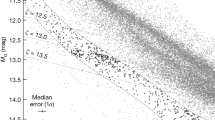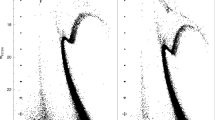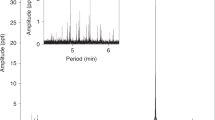Abstract
White dwarfs are stellar embers depleted of nuclear energy sources that cool over billions of years1. These stars, which are supported by electron degeneracy pressure, reach densities of 107 grams per cubic centimetre in their cores2. It has been predicted that a first-order phase transition occurs during white-dwarf cooling, leading to the crystallization of the non-degenerate carbon and oxygen ions in the core, which releases a considerable amount of latent heat and delays the cooling process by about one billion years3. However, no direct observational evidence of this effect has been reported so far. Here we report the presence of a pile-up in the cooling sequence of evolving white dwarfs within 100 parsecs of the Sun, determined using photometry and parallax data from the Gaia satellite4. Using modelling, we infer that this pile-up arises from the release of latent heat as the cores of the white dwarfs crystallize. In addition to the release of latent heat, we find strong evidence that cooling is further slowed by the liberation of gravitational energy from element sedimentation in the crystallizing cores5,6,7. Our results describe the energy released by crystallization in strongly coupled Coulomb plasmas8,9, and the measured cooling delays could help to improve the accuracy of methods used to determine the age of stellar populations from white dwarfs10.
This is a preview of subscription content, access via your institution
Access options
Access Nature and 54 other Nature Portfolio journals
Get Nature+, our best-value online-access subscription
$32.99 / 30 days
cancel any time
Subscribe to this journal
Receive 51 print issues and online access
$199.00 per year
only $3.90 per issue
Buy this article
- Purchase on SpringerLink
- Instant access to full article PDF
Prices may be subject to local taxes which are calculated during checkout




Similar content being viewed by others
Data availability
The Gaia DR2 catalogue of white dwarfs used in this study is available from the University of Warwick astronomy catalogues repository, https://warwick.ac.uk/fac/sci/physics/research/astro/research/catalogues/gaia_dr2_white_dwarf_candidates_v2.csv. All modelling was performed with our extensive white-dwarf evolution code. We have opted not to make this multi-purpose code available, but the cooling sequences calculated for this work are available on request.
References
Mestel, L. On the theory of white dwarf stars. I. The energy sources of white dwarfs. Mon. Not. R. Astron. Soc. 112, 583–597 (1952).
Tassoul, M., Fontaine, G. & Winget, D. E. Evolutionary models for pulsation studies of white dwarfs. Astrophys. J. Suppl. Ser. 72, 335–386 (1990).
van Horn, H. M. Crystallization of white dwarfs. Astrophys. J. 151, 227–238 (1968).
Gaia Collaboration. Gaia Data Release 2. Summary of the contents and survey properties. Astron. Astrophys. 616, A1 (2018).
Garcia-Berro, E., Hernanz, M., Mochkovitch, R. & Isern, J. Theoretical white-dwarf luminosity functions for two phase diagrams of the carbon-oxygen dense plasma. Astron. Astrophys. 193, 141–147 (1988).
Segretain, L. et al. Cooling theory of crystallized white dwarfs. Astrophys. J. 434, 641–651 (1994).
Althaus, L. G., García-Berro, E., Isern, J., Córsico, A. H. & Miller Bertolami, M. M. New phase diagrams for dense carbon-oxygen mixtures and white dwarf evolution. Astron. Astrophys. 537, A33 (2012).
Horowitz, C. J., Schneider, A. S. & Berry, D. K. Crystallization of carbon–oxygen mixtures in white dwarf stars. Phys. Rev. Lett. 104, 231101 (2010).
Hughto, J. et al. Direct molecular dynamics simulation of liquid-solid phase equilibria for a three-component plasma. Phys. Rev. E 86, 066413 (2012).
Winget, D. E., et al. An independent method for determining the age of the universe. Astrophys. J. 315, 77–81 (1987).
Fontaine, G., Brassard, P. & Bergerson, P. The potential of white dwarf cosmochronology. Publ. Astron. Soc. Pacif. 113, 409–435 (2001).
Obertas, A. et al. The onset of convective coupling and freezing in the white dwarfs of 47 Tucanae. Mon. Not. R. Astron. Soc. 474, 677–682 (2018).
García-Berro, E. et al. A white dwarf cooling age of 8 Gyr for NGC 6791 from physical separation processes. Nature 465, 194–196 (2010).
Bédard, A., Bergeron, P. & Fontaine, G. Measurements of physical parameters of white dwarfs: a test of the mass-radius relation. Astrophys. J. 848, 11 (2017).
Gaia Collaboration. Gaia Data Release 2: observational Hertzsprung–Russell diagrams. Astron. Astrophys. 616, A10 (2018).
Hansen, B. M. S. et al. The white dwarf cooling sequence of the globular cluster Messier 4. Astrophys. J. 574, L155–L158 (2002).
Tremblay, P.-E., Kalirai, J. S., Soderblom, D. R., Cignoni, M. & Cummings, J. White dwarf cosmochronology in the solar neighborhood. Astrophys. J. 791, 92 (2014).
Gentile Fusillo, N. P. et al. A Gaia Data Release 2 catalogue of white dwarfs and a comparison with SDSS. Mon. Not. R. Astron. Soc. 482, 4570–4591 (2019).
Tremblay, P.-E., Ludwig, H.-G., Steffen, M. & Freytag, B. Spectroscopic analysis of DA white dwarfs with 3D model atmospheres. Astron. Astrophys. 559, A104 (2013).
El-Badry, K., Rix, H.-W. & Weisz, D. R. An empirical measurement of the initial–final mass relation with Gaia white dwarfs. Astrophys. J. 860, L17 (2018).
Chandrasekhar, S. The highly collapsed configurations of a stellar mass. (Second paper.) Mon. Not. R. Astron. Soc. 95, 207–225 (1935).
Kleinman, S. J. et al. SDSS DR7 white dwarf catalog. Astrophys. J. Suppl. Ser. 204, 5 (2013).
Bergeron, P., Saffer, R. A. & Liebert, J. A spectroscopic determination of the mass distribution of DA white dwarfs. Astrophys. J. 394, 228–247 (1992).
Kalirai, J. S., Richer, H. B., Hansen, B. M. S., Reitzel, D. & Rich, R. M. The dearth of massive, helium-rich white dwarfs in young open star clusters. Astrophys. J. 618, L129–L132 (2005).
Tremblay, P.-E. et al. On the evolution of magnetic white dwarfs. Astrophys. J. 812, 19 (2015).
Kalirai, J. S. et al. Ultra-deep Hubble Space Telescope imaging of the small Magellanic cloud: the initial mass function of stars with M ≲ 1M ⊙. Astrophys. J. 763, 110 (2013).
Bertelli, G., Nasi, E., Girardi, L. & Marigo, P. Scaled solar tracks and isochrones in a large region of the Z–Y plane. II. From 2.5 to 20 M ⊙ stars. Astron. Astrophys. 508, 355–369 (2009).
Potekhin, A. Y. & Chabrier, G. Equation of state of fully ionized electron–ion plasmas. II. Extension to relativistic densities and to the solid phase. Phys. Rev. E 62, 8554–8563 (2000).
Marigo, P. Chemical yields from low- and intermediate-mass stars: model predictions and basic observational constraints. Astron. Astrophys. 370, 194–217 (2001).
Mestel, L. & Ruderman, M. A. The energy content of a white dwarf and its rate of cooling. Mon. Not. R. Astron. Soc. 136, 27–38 (1967).
Acknowledgements
This research received funding from the European Research Council under the European Union’s Horizon 2020 research and innovation programme number 677706 (WD3D) and under the European Union’s Seventh Framework Programme (FP/2007- 2013)/ERC Grant Agreement number 320964 (WDTracer). This work made use of data from the European Space Agency (ESA) mission Gaia (https://www.cosmos.esa.int/gaia), processed by the Gaia Data Processing and Analysis Consortium (DPAC, https://www.cosmos.esa.int/web/gaia/dpac/consortium). Funding for the DPAC was provided by national institutions, in particular the institutions participating in the Gaia Multilateral Agreement. Support for J.J.H. was provided by NASA through Hubble Fellowship grant #HST-HF2-51357.001-A, awarded by the Space Telescope Science Institute, which is operated by the Association of Universities for Research in Astronomy, Inc., under NASA contract NAS5-26555.
Author information
Authors and Affiliations
Contributions
P.-E.T. and B.H.D. identified and characterized the empirical crystallization sequence. G.F. made the evolutionary white-dwarf models used in this work. N.P.G.F., M.A.H. and T.C. constructed the Gaia white-dwarf sample employed in this study and performed the cross-match with other photometric and spectroscopic surveys. P.-E.T., B.T.G., T.R.M., J.J.H. and G.F. wrote the text and developed the argument for a crystallization sequence. E.C. and T.C. characterized the accuracy of Gaia measurements and derived parameters for white dwarfs.
Corresponding author
Ethics declarations
Competing interests
The authors declare no competing interests.
Additional information
Publisher’s note: Springer Nature remains neutral with regard to jurisdictional claims in published maps and institutional affiliations.
Rights and permissions
About this article
Cite this article
Tremblay, PE., Fontaine, G., Fusillo, N.P.G. et al. Core crystallization and pile-up in the cooling sequence of evolving white dwarfs. Nature 565, 202–205 (2019). https://doi.org/10.1038/s41586-018-0791-x
Received:
Accepted:
Published:
Issue date:
DOI: https://doi.org/10.1038/s41586-018-0791-x
This article is cited by
-
A hot white dwarf merger remnant revealed by an ultraviolet detection of carbon
Nature Astronomy (2025)
-
Buoyant crystals halt the cooling of white dwarf stars
Nature (2024)
-
Thermodynamics of diamond formation from hydrocarbon mixtures in planets
Nature Communications (2023)
-
Probing atomic physics at ultrahigh pressure using laser-driven implosions
Nature Communications (2022)
-
Interspecies radiative transition in warm and superdense plasma mixtures
Nature Communications (2020)




VonDuff1
The conclusions and observations seem plausible, and evidentiary.
The underlying assumptions do not conform to physical observations.
Very outdated assumptions, by the astronomy profession ... IMHPO
dougstir Replied to VonDuff1
The standard solar model is incorrect.
Gravity will NOT COMPACT the core.
Please see this article - http://www.teqnicraft.com/i...
VonDuff1
20 years ago, a Nobel Prize was awarded for use of the Hubble Telescope,
to measure the meteoric volume hitting the earth’s atmosphere. An immense
volume of ICE is added to the earth each year, also stone meteors. It had
previously been assumed that most meteors were metallic. However, the evidence indicates that the greatest meteoric mass is ice crystals, followed by stone meteors, and metallic meteors are the least mass which are added to the earth. Metal & stone meteors produced light flashes, and ripples, upon entering the earth's atmosphere. Ice crystals produced atmospheric ripples upon impact, but no light flashes from friction/heat.
Ergo: Our Sun is receiving vast quantities of additional mass as it moves through the galaxy.
VonDuff1
Reportably (and plausibly) Our Solar System travels at an average velocity of 828,000 km/h (230 km/s) or 514,000 mph (143 mi/s) within its trajectory around the Milky Way galactic center, a speed at which an object could circumnavigate the Earth’s equator in 2 minutes and 54 seconds; that speed corresponds to approximately 1/1300 of the speed of light.
And, I posit … The Sun is being refueled with VAST volumes/mass in the forms of ice, stone & metal meteors along the way. The Perseid meteor shower each August is our easiest vantage point to observe the solar refueling process. The solar output responds to this fueling, in presently undetermined ways.
VonDuff1
To properly study and predict the energy production of the Sun and the effect on Earth’s climate, we would need satellites on the leading edge of the Solar System, i.e. in front of the Sun. These satellites could monitor the matter being swept into the Sun, which presumably become its fuel. Leading and trailing solar satellites in the outer reaches of the Sun’s gravitational field, would give us a clearer ‘before and after picture of the mass added to the Sun each day, year, century.
I posit that the Sun and other stars are dependent upon this continuing mass accretion process for fuel, and their: form, size, mass, thermal output, and color are quickly affected thereby.
VonDuff1
In the 1st order analysis, the refueling of the Sun seems to be critical to aging calculations.
So, if the refueling is neglected, it is difficult to consider the analysis and projections to represent a serious effort.
VonDuff1
https://s22380.pcdn.co/wp-c...
Robert Potter
The sun (1 solar mass) has no mechanism to introduce new hydrogen into the core, where the fusion takes place. That is why it's lifetime is on the order of 10 billion years. In fact, the sun will only consume a tiny fraction of it's hydrogen during its lifetime.
Contrast this to a red dwarf star of only 0.5 solar mass. This star is totally convective, which means it can supply the core with new H as it's used up. Because of this, not a single red dwarf start has ever died yet! Most will take hundreds of billions of year to exhaust their hydrogen. Stars with a mass of 0.4 solar mass will live to be something like 800 billions years or more!
Also, the sun may accumulate mass as it orbits the center of the galaxy, but that accumulated material will never reach the core of the sun, so that process won't help to extend the life of the sun at all.
VonDuff1 Replied to Robert Potter
Robert Potter,
The penetration depth of the circulation into the solar core is possibly
dependent upon tachocline turbulence, rather than absent entirely. The
available observation & modeling are inadequate to establish your
contention, to a high degree of reliability. IMHPO
VonDuff1 Replied to VonDuff1
Same Robert Potter? Subaru Observation System Associate at Subaru Telescope, Location: 650 North A'ohoku Pl., Hilo, Hawaii, United States, Subaru Telescope: Ph: (808) 934-5900, Updated:12/11/2018, https://subarutelescope.org/
The Subaru telescope is Japan's premier optical-infrared telescope operated by the National Astronomical Observatory of Japan. Located on Maunakea on the island of Hawaii, the telescope, with an effective aperture of 8.2 m, is also one of the world's largest and most technologically advanced telescopes. Through the open use program astronomers throughout the world have access to Subaru's excellent image quality.
Thanks for contributing.
VonDuff1
http://www.aip.de/en/resear...
VonDuff1
http://www.aip.de/en/resear...